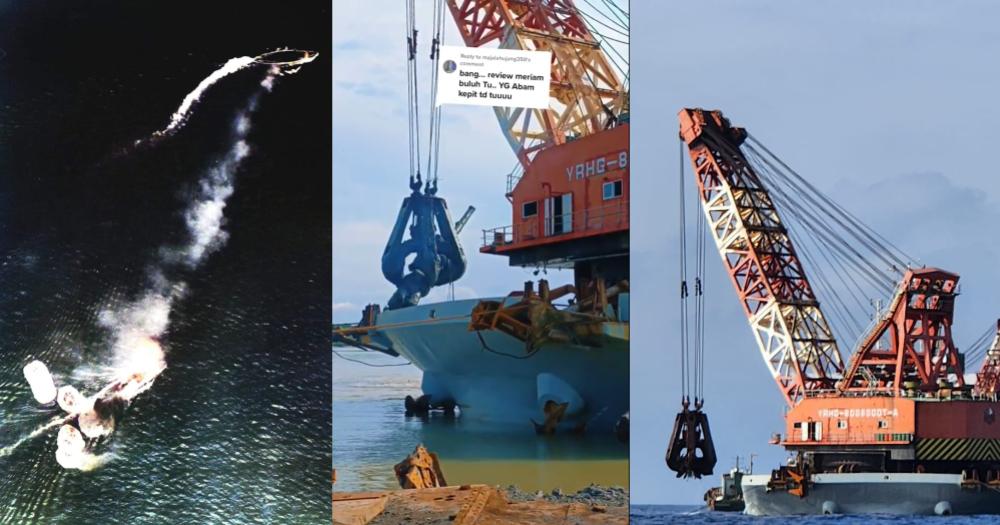Follow us on Telegram for the latest updates: https://t.me/mothershipsg
In 2015, there was an outcry after scavengers were discovered targeting the wrecks of World War Two era British warships near Malaysia.
Now it appears that the scavengers have returned, after Malaysian fishermen spotted dredging equipment near the site.
Illegal salvage
According to the New Straits Times, local Malaysian fishermen and boat operators have spotted maritime salvage equipment near the wrecks of two WW2 British warships.
The wrecks of the Prince of Wales and the Repulse, sunk by the Japanese Navy in the opening days of World War 2, are a popular site for divers and fishermen.
Malaysian professional diver Hazz Zain told the New Straits Times that boat operators she had spoken to had shared pictures with her of a grab dredger operating in the area, first spotting it in April 2023.
The pictures were taken by some fishermen who regularly fished near the wrecks, as there were usually a lot of fish.
When they saw the dredger, they approached it, but were warded off by a nearby boat who told them not to enter the site.
Videos and pictures being shared on social media show a barge named Chuan Hong 68 operating at sea, and is alleged to have been the same ship spotted by the fishermen.
The Chuan Hong 68 has been named as the ship responsible for earlier attempts to salvage the ships, as well as several other WW2 wrecks in the region, including Indonesia.
In 2017, a ship named Chuan Hong 68 suspected of illegal activity and allegedly destroying Japanese shipwrecks was detained by the Malaysian authorities.
The Chuan Hong 68 is said to be a China-flagged ship, leading to British media outlets such as tabloid The Sun attributing the salvage attempts to China.
However, a video posted on social media shows the barge offloading what appears to be a naval gun in Pengerang, Johor. Hazz told NST that a friend told her about videos on social media apparently showing ship relics taken to a spot near the same location.
The video was originally posted to TikTok, but apparently has since deleted all related pictures and footage from its account.
A history of violence
The site of the wrecks are considered war graves, as the resting place of over 800 British sailors who were killed when the Imperial Japanese Navy attacked on Dec. 10, 1941.
Tenggelamnya kapal HMS Prince of Wales dan HMS Repulse, 10 Disember 1941. Gambar diambil dari pesawat Jepun semasa serangan pengeboman. Repulse, di bahagian bawah baru saja terkena sebutir bom dan hampir terkena beberapa butir bom lagi. pic.twitter.com/F6fvLlCYy1
— 𝕏 (@Hfnz9) May 18, 2023
The ships were the centrepiece of Task Force Z, and were based in Singapore in order to prepare for an expected Japanese invasion.
The wrecks have rested about 100km off the east coast of peninsular Malaysia, but in the past decade there have been several attempts to illegally salvage the wrecks.
The New Straits Times reported that in 2015, non-Malaysian salvagers used explosives as part of their attempt to salvage the ships' steel plates, but were stopped by the Malaysian Navy and Maritime Enforcement Agency.
Salvage attempts continued until at least 2017, but no new activity was seen until 2023.
Hazz recounted her meeting with King Charles III in 2017, when he was Prince of Wales.
She showed him pictures of the wreck, noting that he looked 'upset', and he commented that "60 to 70 per cent" of the wreck had already been salvaged.
Hazz says that she has informed the Malaysian authorities as well as the British High Commission in Kuala Lumpur.
Why is pre-1945 steel valuable?
The Sun used the word "fury" to describe British reaction, quoting a former Sea Lord (naval official) as saying the news was "extremely worrying" and that the British could only rely on Malaysian authorities to look after the wrecks.
The metals in the wrecks are uniquely valuable, as they were forged prior to the advent of nuclear weapons.
Since 1945, nuclear testing has raised the background radiation of the earth enough that steel smelted since then is slightly radioactive, according to the Royal Society of Chemistry.
Hence, pre-1945 steel has become sought after for use in for hospital and scientific equipment, as it has a significantly lower level of background radiation.
You might be interested
Top image via @Hfnz9/Twitter
If you like what you read, follow us on Facebook, Instagram, Twitter and Telegram to get the latest updates.

